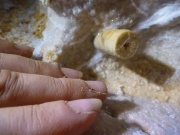Fossils (Inventory)/Crinoid
From LagWiki
(Difference between revisions)
m (moved Crinoid (Inventory) to Fossils (Inventory)/Crinoid) |
|||
| Line 6: | Line 6: | ||
A complete crinoid looks like a lily complete with what appear to be roots, a stem and a flower; but, they are not plants at all but animals. Any portion may be exposed as a fossil; but, usually, the fossils are a cross section of the long stem portion and it appears like a stack of buttons. | A complete crinoid looks like a lily complete with what appear to be roots, a stem and a flower; but, they are not plants at all but animals. Any portion may be exposed as a fossil; but, usually, the fossils are a cross section of the long stem portion and it appears like a stack of buttons. | ||
| - | ==References== | + | ===References=== |
*Palmer, Arthur N. (2007) ''Cave Geology'' CAVE BOOKS, Dayton, OH p 72 ISBN-13: [[Special:Booksources/978-0-939748-66-2|978-0-939748-66-2]], ISBN-10: [[Special:Booksources/0-939748-66-5|0-939748-66-5]] | *Palmer, Arthur N. (2007) ''Cave Geology'' CAVE BOOKS, Dayton, OH p 72 ISBN-13: [[Special:Booksources/978-0-939748-66-2|978-0-939748-66-2]], ISBN-10: [[Special:Booksources/0-939748-66-5|0-939748-66-5]] | ||
| - | + | <noinclude> | |
{{Cave inventory}} | {{Cave inventory}} | ||
| + | </noinclude> | ||
Revision as of 17:48, 21 April 2011
The Crinoid field should be used to record stations where crinoid fossils are found.
Crinoids are a marine animal which may be preserved in the bedrock as fossils. These fossils may then be exposed.
A complete crinoid looks like a lily complete with what appear to be roots, a stem and a flower; but, they are not plants at all but animals. Any portion may be exposed as a fossil; but, usually, the fossils are a cross section of the long stem portion and it appears like a stack of buttons.
References
- Palmer, Arthur N. (2007) Cave Geology CAVE BOOKS, Dayton, OH p 72 ISBN-13: 978-0-939748-66-2, ISBN-10: 0-939748-66-5

